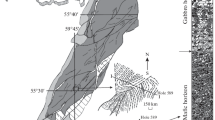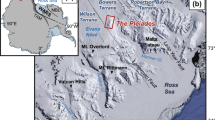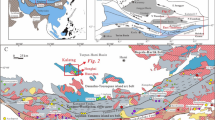Abstract
Silicate and sulfide melt inclusions from the andesitic Farallón Negro Volcanic Complex in NW Argentina were analyzed by laser ablation ICPMS to track the behavior of Cu and Au during magma evolution, and to identify the processes in the source of fluids responsible for porphyry-Cu-Au mineralization at the 600 Mt Bajo de la Alumbrera deposit. The combination of silicate and sulfide melt inclusion data with previously published geological and geochemical information indicates that the source of ore metals and water was a mantle-derived mafic magma that contained approximately 6 wt.% H2O and 200 ppm Cu. This magma and a rhyodacitic magma mixed in an upper-crustal magma chamber, feeding the volcanic systems and associated subvolcanic intrusions over 2.6 million years. Generation of the ore fluid from this magma occurred towards the end of this protracted evolution and probably involved six important steps: (1) Generation of a sulfide melt upon magma mixing in some parts of the magma chamber. (2) Partitioning of Cu and Au into the sulfide melt (enrichment factor of 10,000 for Cu) leading to Cu and Au concentrations of several wt.% or ppm, respectively. (3) A change in the tectonic regime from local extension to compression at the end of protracted volcanism. (4) Intrusion of a dacitic magma stock from the upper part of the layered magma chamber. (5) Volatile exsolution and resorption of the sulfide melt from the lower and more mafic parts of the magma chamber, generating a fluid with a Cu/Au ratio equal to that of the precursor sulfide. (6) Focused fluid transport and precipitation of the two metals in the porphyry, yielding an ore body containing Au and Cu in the proportions dictated by the magmatic fluid source. The Cu/S ratio in the sulfide melt inclusions requires that approximately 4,000 ppm sulfur is extracted from the andesitic magma upon mixing. This exceeds the solubility of sulfide or sulfate in either of the silicate melts and implies an additional source for S. The extra sulfur could be added in the form of anhydrite phenocrysts present in the rhyodacitic magma. It appears, thus, that unusually sulfur-rich, not Cu-rich magmas are the key to the formation of porphyry-type ore deposits. Our observations imply that dacitic intrusions hosting the porphyry–Cu–Au mineralization are not representative of the magma from which the ore-fluid exsolved. The source of the ore fluid is the underlying more mafic magma, and unaltered andesitic dikes emplaced immediately after ore formation are more likely to represent the magma from which the fluids were generated. At Alumbrera, these andesitic dikes carry relicts of the sulfide melt as inclusions in amphibole. Sulfide inclusions in similar dykes of other, less explored magmatic complexes may be used to predict the Au/Cu ratio of potential ore-forming fluids and the expected metal ratio in any undiscovered porphyry deposit.









Similar content being viewed by others
References
Allmendinger RW (1986) Tectonic development, southeastern border of the Puna plateau, Northwestern Argentine Andes. Geol Soc Am Bull 97:1070–1082
Audetat A, Gunther D, Heinrich CA (1998) Formation of a magmatic-hydrothermal ore deposit: insights with LA-ICP-MS analysis of fluid inclusions. Science 279:2091–2094
Audetat A, Pettke T, Dolejs D (2004) Magmatic anhydrite and calcite in the ore-forming quartz- monzodiorite magma at Santa Rita, New Mexico (USA): genetic constraints on porphyry-Cu mineralization. Lithos 72:147–161
Bain N (2001) Petrological and geochemical contribution to the Farallón Negro Volcanic Complex, NW-Argentina. Diploma Thesis. Swiss Federal Institute of Technology, Zurich, 92 pp
Bassi HGL, Rochefort G (1980) Estudio geologico del yacimiento cuproaurifero de la Alumbrera. Servicio Minero Nacional, Buenos Aires
Becker K (2001) Sm-Nd and Rb-Sr isotope geochemistry on the magmatic source of the igneous rocks in the Farallón Negro Volcanic Complex, NW Argentina. Diploma Thesis. Swiss Federal Institute of Technology, Zurich, 103 pp
Bodnar RJ, Rapien RH, Simmons S, Szabo CS, Wood CP, Sutton SR (2002) Neo-natal porphyry copper system at White Island, New Zealand. Geochim Cosmochim Acta 66:A86–A86
Candela PA, Holland HD (1984) The partitioning of copper and molybdenum between silicate melts and aqueous fluids. Geochim Cosmochim Acta 48:373–380
Carroll MR, Rutherford MJ (1985) Sulfide and sulfate saturation in hydrous silicate melts. J Geophys Res 90:C601–C612
Charlier BLA, Peate DW, Wilson CJN, Lowenstern JB, Storey M, Brown SJA (2003) Crystallisation ages in coeval silicic magma bodies: U-238-Th- 230 disequilibrium evidence from the Rotoiti and Earthquake Flat eruption deposits, Taupo Volcanic Zone, New Zealand. Earth Planet Sci Lett 206:441–457
Coughlin TJ, O’Sullivan PB, Kohn BP, Holcombe RJ (1998) Apatite fission-track thermochronology of the Sierras Pampeanas, central western Argentina; implications for the mechanism of plateau uplift in the Andes. Geology (Boulder) 26:999–1002
Dilles JH (1987) Petrology of the Yerington Batholith, Nevada—evidence for evolution of porphyry copper ore fluids. Econ Geol 82:1750–1789
Dungan MA, Wulff A, Thompson R (2001) Eruptive stratigraphy of the Tatara-San Pedro complex, 36°S, southern volcanic zone, Chilean Andes: reconstruction method and implications for magma evolution at long-lived arc volcanic centers. J Petrol 42:555–626
Ewart A (1982) The mineralogy and petrology of tertiary-recent orogenic volcanic rocks; with special reference to the andesitic-basaltic compositional range. In: Thorpe RS (ed) Andesites; orogenic andesites and related rocks. Wiley, Chichester, pp 25–95
Guilbert JM (1995) Geology, alteration, mineralization, and genesis of the Bajo de la Alumbrera porphyry copper-gold deposit, Catamarca Province, Argentina. In: Pierce FW, Bolm JG (eds) Porphyry copper deposits of the American Cordillera: Arizona Geological Society Digest, vol 20. Arizona Geological Society, Tucson, pp 646–656
Gunther D, Audetat A, Frischknecht R, Heinrich CA (1998) Quantitative analysis of major, minor and trace elements in fluid inclusions using laser ablation inductively coupled plasma mass spectrometry. J Anal Atom Spectrom 13:263–270
Gustafson LB, Hunt JP (1975) The porphyry copper deposit at El Salvador, Chile. Econ Geol Bull Soc Econ Geol 70:857–912
Halter WE, Pettke T, Heinrich CA (2002a) The origin of Cu/Au ratios in porphyry-type ore deposits. Science 296:1844–1846
Halter WE, Pettke T, Heinrich CA, Rothen-Rutishauser B (2002b) Major to trace element analysis of melt inclusions by laser-ablation ICP-MS: methods of quantification. Chem Geol 183:63–86
Halter WE, Bain N, Becker K, Heinrich CA, Landtwing M, VonQuadt A, Bissig T, Clark AH, Sasso AM, Tosdal RM (2004a) From andesitic volcanism to the formation of a porphyry-Cu-Au mineralizing magma chamber: The Farallón Negro Volcanic Complex, northwestern Argentina. J Volcanol Geotherm Res (in press)
Halter WE, Heinrich CA, Pettke T (2004b) Laser-ablation ICP-MS analysis of silicate and sulfide melt inclusions in an andesitic complex II: magmas genesis and implications for ore-formation. Contrib Mineral Petrol 147:397–412
Halter WE, Pettke T, Heinrich CA (2004c) Laser-ablation ICP-MS analysis of silicate and sulfide melt inclusions in an andesitic complex I: analytical approach and data evaluation. Contrib Mineral Petrol 147:385–396
Harris AC, Kamenetsky VS, White NC, van Achterbergh E, Ryan CG (2003) Melt inclusions in veins: linking magmas and porphyry Cu deposits. Science 302:2109–2111
Harris AC, Allen CM, Bryan SE, Campbell IH, Holcombe RJ, Palin JM (2004) ELA-ICP-MS U-Pb zircon geochronology of regional volcanism hosting the Bajo de la Alumbrera Cu-Au deposit: implications for porphyry-related mineralization. Miner Deposita 39:46–67
Hattori K (1993) High-sulfur magma, a product of fluid discharge from underlying mafic magma—evidence from Mount-Pinatubo, Philippines. Geology 21:1083–1086
Hattori K (1996) Occurrence and origin of sulfide and sulfate in the 1991 Mount Pinatubo eruption products. In: Newhall Christopher G, Punongbayan Raymundo S (eds) Fire and mud; eruptions and lahars of Mount Pinatubo, Philippines, Philippine Institute of Volcanology and Seismology. University of Washington Press, United States, Quezon City, Philippines, pp 807–824
Hedenquist JW, Simmons SF, Giggenbach WF, Eldridge CS (1993) White-Island, New-Zealand, volcanic-hydrothermal system represents the geochemical environment of high-sulfidation Cu and Au ore deposition. Geology 21:731–734
Heinrich CA, Ryan CG, Mernagh TP, Eadington PJ (1992) Segregation of ore metals between magmatic brine and vapor—a fluid inclusion study using pixe microanalysis. Econ Geol Bull Soc Econ Geol 87:1566–1583
Heinrich CA, Pettke T, Halter WE, Aigner-Torres M, Audetat A, Gunther D, Hattendorf B, Bleiner D, Guillong M, Horn I (2003) Quantitative multi-element analysis of minerals, fluid and melt inclusions by laser-ablation inductively-coupled-plasma mass-spectrometry. Geochim Cosmochim Acta 67:3473–3497
Heinrich CA, Driesner T, Stefansson A, Seward TM (2004) Magmatic vapor contraction and the transport of gold from the porphyry environment to epithermal ore deposits. Geology 32:761–764
Hezarkhani A, Williams-Jones AE (1998) Controls of alteration and mineralization in the Sungun porphyry copper deposit, Iran: evidence from fluid inclusions and stable isotopes. Econ Geol Bull Soc Econ Geol 93:651–670
Hezarkhani A, Williams-Jones AE, Gammons CH (1999) Factors controlling copper solubility and chalcopyrite deposition in the Sungun porphyry copper deposit, Iran. Miner Deposita 34:770–783
Housh TB, Luhr JF (1991) Plagioclase-melt equilibria in hydrous systems. Am Miner 76:477–492
Hunt JP (1991) Porphyry copper deposits: Historical perspectives of genetic concepts and case histories of famous discoveries: economic Geology Monographs, vol 8. Economic Geology Publishing Co., Lancaster, pp 192–206
Johannes W (1989) Melting of plagioclase-quartz assemblages at 2-Kbar Water-pressure. Contrib Mineral Petrol 103:270–276
Jordan TE, Allmendinger RW (1986) The sierra pampeanas of Argentina: a moderne analogue of Rocky Mountain foreland deformation. Am J Sci 260:737–764
Jugo PJ, Candela PA, Piccoli PM (1999) Magmatic sulfides and Au:Cu ratios in porphyry deposits: an experimental study of copper and gold partitioning at 850°C, 100 MPa in a haplogranitic melt pyrrhotite intermediate solid solution gold metal assemblage, at gas saturation. Lithos 46:573–589
Keith JD, Whitney JA, Hattori K, Ballantyne GH, Christiansen EH, Barr DL, Cannan TM, Hook CJ (1997) The role of magmatic sulfides and mafic alkaline magmas in the Bingham and Tintic mining districts, Utah. J Petrol 38:1679–1690
Keppler H (1999) Experimental evidence for the source of excess sulfur in explosive volcanic eruptions. Science 284:1652–1654
Kesler SE, Chryssoulis SL, Simon G (2002) Gold in porphyry copper deposits: its abundance and fate. Ore Geol Rev 21:103–124
Kress V (1997) Magma mixing as a source for Pinatubo sulphur. Nature 389:591–593
Landtwing M (2004) Fluid evolution and ore metal precipitation at the Bingham porphyry Cu-Au-Mo deposit, Utah, deduced from cathodoluminescence imaging and LA-ICPMS microanalysis of fluid inclusions. PhD Thesis, ETH Zurich, Zurich, 126 pp
Larocque ACL, Stimac JA, Keith JD, Huminicki MAE (2000) Evidence for open-system behavior in immiscible Fe-S-O liquids in silicate magmas: Implications for contributions of metals and sulfur to ore-forming fluids. Can Mineral 38:1233–1249
Llambías EJ (1970) Geologia de los yacimientos mineros Agua de Dionisio, Prov. de Catamarca, Rep. Argentina. Revista de la Asociacion Argentina de Mineralogia Petrologia y Sedimentologia 1:2–32
Llambías EJ (1972) Estructura del grupo volcanico Farallon Negro, Catamarca, Republica Argentina. Revista de la Asociacion Geologica Argentina 27:161–169
Lowell JD, Guilbert JM (1970) Lateral and vertical alteration-mineralization zoning in porphyry ore deposits. Econ Geol Bull Soc Econ Geol 65:373–408
Lowenstern JB (1993) Evidence for a copper-bearing fluid in magma erupted at the Valley of Ten-Thousand-Smokes, Alaska. Contrib Mineral Petrol 114:409–421
Moore G, Carmichael ISE (1998) The hydrous phase equilibria (to 3 kbar) of an andesite and basaltic andesite from western Mexico: constraints on water content and conditions of phenocryst growth. Contrib Mineral Petrol 130:304–319
Oberli F, Meier M, Berger A, Rosenberg CL, Giere R (2004) U-Th-Pb and Th-230/U-238 disequilibrium isotope systematics: precise accessory mineral chronology and melt evolution tracing in the Alpine Bergell intrusion. Geochim Cosmochim Acta 68:2543–2560
O’Neill HSC, Mavrogenes JA (2002) The sulfide capacity and the sulfur content at sulfide saturation of silicate melts at 1400°C and 1 bar. J Petrol 43:1049–1087
Pallister JS, Hoblitt RP, Reyes AG (1992) A basalt trigger for the 1991 eruptions of Pinatubo Volcano. Nature 356:426–428
Parat F, Dungan MA, Streck MJ (2002) Anhydrite, pyrrhotite, and sulfur-rich apatite: tracing the sulfur evolution of an Oligocene andesite (Eagle Mountain, CO, USA). Lithos 64:63–75
Pettke T, Halter WE, Webster JD, Aigner-Torres M, Heinrich CA (2004) Accurate quantification of melt inclusion chemistry by LA-ICPMS: a comparison with EMP and SIMS and advantages and possible limitations of these methods. Lithos 78:333–361
Proffett JM (2003) Geology of the Bajo de la Alumbrera porphyry copper-gold deposit, Argentina. Econ Geol Bull Soc Econ Geol 98: 1535–1574 ; 1534 sheets
Redmond PB, Landtwing MR, Einaudi MT (2001) Cycles of porphyry dike emplacement, veining, alteration and mineralisation in the Bingham porphyry Cu-Au-Mo deposit, Utah. In: Piestrzynski A et al (eds) Mineral deposits at the beginning of the 21st century. Society for Geology Applied to Mineral Deposits (SGA). International, Krakow
Sasso AM (1997) Geological evolution and metallogenetic relationships of the Farallon Negro volcanic complex, NW Argentina. PhD Thesis. Queen’s University, 843 pp
Sasso AM, Clark AH (1998) The farallón negro group, northwest Argentina: magmatic, hydrothermal and tectonic evolution and implications for Cu-Au metallogeny in the Andean back-arc. Soc Econ Geol Newslett 34:8–17
Sillitoe RH (1973) The tops and bottoms of porphyry copper deposits. Econ Geol Bull Soc Econ Geol 68:799–815
Sparks RSJ, Marshall LA (1986) Thermal and mechanical constraints on mixing between mafic and silicic magmas. J Volcanol Geotherm Res 29:99–124
Spooner ETC (1993) Magmatic sulfide volatile interaction as a mechanism for producing chalcophile element enriched, Archean Au-quartz, epithermal Au-Ag and Au skarn hydrothermal ore F fluids. Ore Geol Rev 7:359–379
Stefanini B, Williams-Jones AE (1996) Hydrothermal evolution in the Calabona porphyry copper system (Sardinia, Italy): the path to an uneconomic deposit. Econ Geol Bull Soc Econ Geol 91:774–791
Stults A (1985) Geology of the Bajo de la Alumbrera porphyry copper and gold prospect, Catamarca province, Argentina. Masters Thesis, University of Arizona, Tuscon, 75 pp
Sun WD, Arculus RJ, Kamenetsky VS, Binns RA (2004) Release of gold-bearing fluids in convergent margin magmas prompted by magnetite crystallization. Nature 431:975–978
Tomkins AG, Mavrogenes JA (2003) Generation of metal-rich felsic magmas during crustal anatexis. Geology 31:765–768
Ulrich T (1999) Genesis of the Bajo de la Alumbrera porphyry Cu-Au deposit, Argentina: geological, fluid geochemical, and isotopic implications. Doctoral Thesis, Swiss Federal Institute of Technology, Zurich, 207 pp
Ulrich T, Heinrich CA (2001) Geology and alteration geochemistry of the porphyry Cu-Au deposit at Bajo de la Alumbrera, Argentina, vol 96, p 1719, 2001, correctly printed in 2002. Econ Geol Bull Soc Econ Geol 97:1863–1888
Ulrich T, Gunther D, Heinrich CA (1999) Gold concentrations of magmatic brines and the metal budget of porphyry copper deposits. Nature 399:676–679
Ulrich T, Gunther D, Heinrich CA (2001) Evolution of a porphyry Cu-Au deposit, based on LA-ICP-MS analysis of fluid inclusions: Bajo de la Alumbrera, Argentina, vol 96, p 1743, 2001, correctly printed in 2002. Econ Geol Bull Soc Econ Geol 97:1888–1920
Urreiztieta M, Rosello EA, Gapais D, LeGorve C, Cobbold PR 1993. Neogene dextural transpression at the southern edge of the Altiplano-Puna (NW Argentina). In: IInd international symposium on andean tectonics, Oxford, pp 267–269
Wallace PJ, Gerlach TM (1994) Magmatic vapor source for sulfur-dioxide released during volcanic-eruptions—evidence from Mount-Pinatubo. Science 265:497–499
Walshe JL, Cooke DR, Cannell J, Frikken P, Hollings P, Masterman G, Skarmeta J, Camus F, Gow PA, Midgley G (2003) Physicochemical gradients and architectural constraints on fluid-mixing models of porphyry Cu formation. In: Eliopoulos DG et al (eds) Mineral exploration and sustainable development. Mill press, Athens, pp 419–422
Watson EB (1979) Zircon saturation in felsic liquids—experimental results and applications to trace-element geochemistry. Contrib Mineral Petrol 70:407–419
Wolf KJ, Eichelberger JC (1997) Syneruptive mixing, degassing, and crystallization at Redoubt Volcano, eruption of December, 1989 to May 1990. J Volcanol Geotherm Res 75:19–37
Acknowledgements
This study was partly supported by ETH research funds and by the Swiss National Science Foundation (grant 20-59544-99 to CAH). Extensive logistic support was granted by Minera Alumbrera Ltd. and MIM Exploration, and we would like to thank Dave Keough and Steve Brown, in particular, for their help. Mario Alderete and Nicolás Montenegro, from YMAD (Tucumán, Argentina) provided authorization to access the Farallón Negro exploration prospect and on site support. Many thanks also to Jim Webster and Bernd Lehmann, whose comments helped to improve the manuscript significantly.
Author information
Authors and Affiliations
Corresponding author
Additional information
Editorial handling: B. Lehmann
Rights and permissions
About this article
Cite this article
Halter, W.E., Heinrich, C.A. & Pettke, T. Magma evolution and the formation of porphyry Cu–Au ore fluids: evidence from silicate and sulfide melt inclusions. Miner Deposita 39, 845–863 (2005). https://doi.org/10.1007/s00126-004-0457-5
Received:
Accepted:
Published:
Issue Date:
DOI: https://doi.org/10.1007/s00126-004-0457-5




